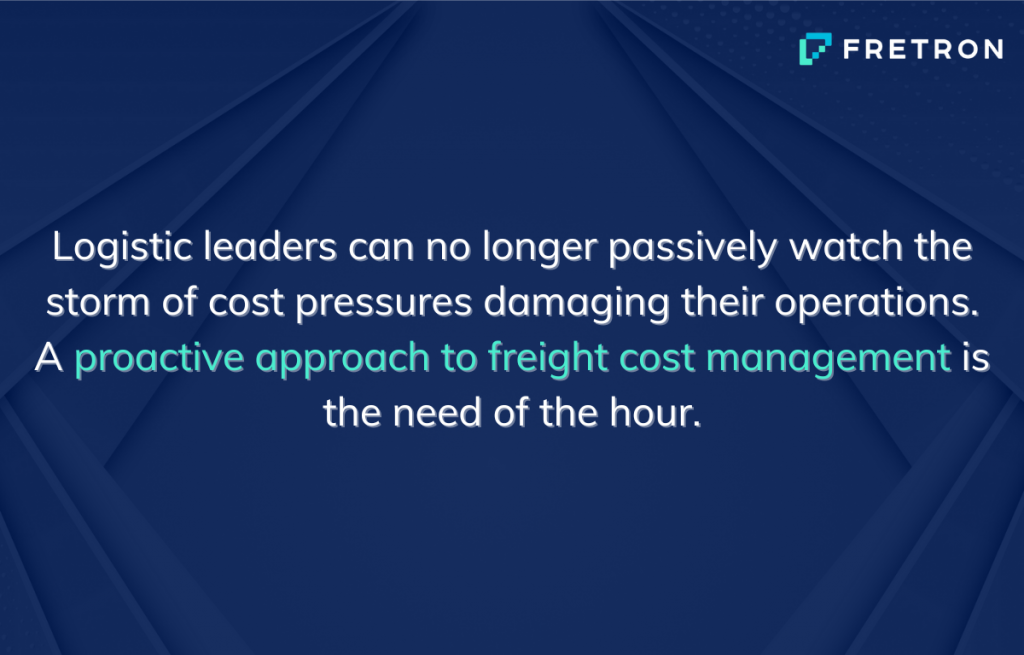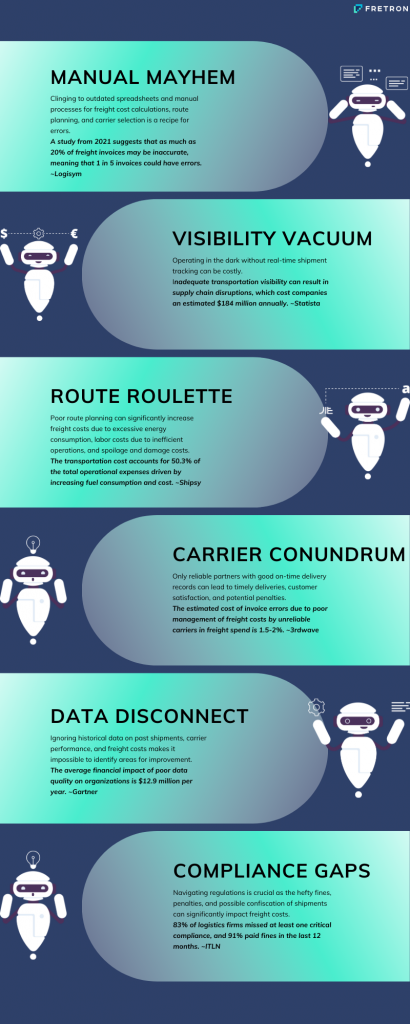
The world of logistics is experiencing a perfect storm of cost pressures. Fuel prices are skyrocketing due to global events and supply chain disruptions. Ports are overflowing with cargo, leading to capacity constraints and soaring container fees. Meanwhile, consumer demand for goods remains strong. These factors, combined with volatile market fluctuations, are creating a major headache for logistics and supply chain leaders: spiraling freight costs.
Transportation often represents a significant chunk of a company’s budget, and even a small change here and there can eat away at profits. At this point, logistics leaders can no longer afford to be passive observers. They must take a proactive approach to freight cost management by identifying and eliminating inefficiencies in their transportation operations.
While we can’t control external factors like fuel prices or port congestion, we can optimize our internal operations to weather the storm. Here’s the harsh reality: any internal mistakes in your logistics management system can be the tipping point on top of these external pressures. Missed compliance, inefficient route planning, or a lack of real-time visibility – these vulnerabilities can have a ripple effect throughout the organization, impacting inventory management, customer satisfaction, and overall business competitiveness.
The good news? By prioritizing internal optimization, you can not only navigate external challenges but also significantly reduce freight costs.

To start the optimization, it’s essential to begin by exposing the common mistakes that potentially and silently drain the freight budget of businesses.
Underutilizing Carrier Performance Data: Without analyzing carrier performance data, logistics teams might continue partnering with underperforming and unreliable carriers, affecting both costs and service quality.
Neglecting Carrier Rate Benchmarking: Failing to regularly compare and benchmark carrier rates against market standards can lead to persistently overpaying for freight services.
Weak Procurement Strategies: Settling for one-off quotes without negotiating long-term contracts, rate negotiations, or exploring online freight marketplaces can lead you to miss out on better rates and cost-saving opportunities.
Sticking with Manual Processes: Manually performing carrier selection, route planning, order indentation, POD, etc. is error-prone and time-consuming, ultimately leading to higher transportation costs.
Lack of Visibility into Shipments: Not having real-time tracking information can lead to delays in identifying and resolving issues, potentially resulting in missed deliveries, customer dissatisfaction, and increased transportation costs.
Inefficient Route Planning: Neglecting to optimize routes for factors like traffic congestion, fuel efficiency, and driver breaks can lead to wasted miles and unnecessary fuel consumption, significantly increasing your transportation spending.
Overlooking Mode Optimization: By not dynamically selecting the most cost-effective transportation mode (LTL, FTL, parcel, intermodal, etc.) based on shipment size, destination, and urgency, logistics teams miss out on potential savings.
Failing to Analyze Historical Data: Ignoring historical data on past shipments, route optimizations, carrier performance, and freight costs makes it impossible to identify areas for improvement, lead negotiations, and save costs ultimately.
Evolving Regulatory Landscape: Non-compliance with governmental regulations related to vehicle emissions, safety standards, and driver compliance can lead to fines, delays, and potential impounding of vehicles, increasing overall freight costs.
Neglecting Green Logistics: Companies indifferent to exploring options like intermodal transport, route optimization for fuel efficiency, and investing in electric or alternative fuel vehicles are missing out on cost savings and customer service improvements.
Ignoring Industrial Technology Advancements: Failing to stay informed about industry trends like automation, IoT, AI & Analytics, etc. can leave your company at a disadvantage towards cost savings.
Poor Communication with Different Departments: The inability to effectively communicate with departments and stakeholders can lead to mismatched forecasts, order fulfillment issues, and ultimately, increased transportation costs.
Some more mistakes that often get overlooked:
Unprepared for Peak Seasons: Being unprepared for peak logistics seasons leads to last-minute scrambling and inflated costs due to the lack of secured capacity or pre-negotiated rates.
Miscalculating Weight and Dimensions: Minor inaccuracies in weight and dimensions can significantly inflate costs through overpayments or fines and delays from necessary re-measurements.
Ignoring Packaging Optimization: Overlooking packaging optimization by neglecting size, materials, and product characteristics results in damaged goods and increased costs due to returns and reshipments.
Mismanaged Free Shipping Offers: Offering free shipping without carefully managing related costs can significantly reduce profit margins.
Overlooking Accessorial Charges: Not accounting for potential accessorial charges leads to unexpected expenses that could have been negotiated or mitigated.
Opaque 3PL Costs: Lack of transparency in 3PL provider costs, including hidden fees and markups, can unexpectedly increase freight spend.
Neglecting Backhaul Opportunities: Missing the opportunity to negotiate backhauls results in unutilized capacity, draining the freight budget and missing potential revenue.
Insufficient Logistics Staff Training: Failing to invest in logistics staff training on key operations like route optimization and carrier selection leads to operational inefficiencies and errors.
Having discussed much about the possible mistakes logistics stakeholders can make, let’s also take a look at their quantifiable impact on freight costs:

The relentless rise of freight costs can squeeze profit margins and leave logistics teams scrambling for solutions. But fear not! By implementing these best practices and strategic approaches, you can slay the freight cost beast and achieve sustainable savings.
Leverage Data-Driven Decisions: Data is your key to informed decisions. Utilize historical data on past shipments, carrier performance, and freight costs to identify areas for improvement. This allows you to negotiate better rates, optimize routes, and make strategic decisions that reduce freight costs.
Invest in a TMS: A TMS is your digital weapon against inefficiency. It automates tasks like quoting, route planning, and carrier selection, reducing errors and ensuring optimal routes. This can translate to significant fuel cost savings and improved efficiency.
Invest in warehouse automation: Automating processes like picking and packing in your warehouse can improve efficiency, optimize loading, and potentially reduce transportation costs.
Route Planning Prowess: Utilize data-driven route optimization tools to consider traffic patterns, axle load limits, and fuel efficiency. Minimize empty miles and optimize fuel consumption for substantial cost savings.
Carrier Selection with a Keen Eye: Negotiate long-term contracts with reliable carriers based on performance and cost. Explore online freight marketplaces for competitive quotes and explore backhauls (transporting goods on return trips) to maximize resource utilization.
Promote shipment consolidation: Combine smaller shipments into larger ones to benefit from economies of scale and lower per-unit transportation costs.
Explore Intermodal Transport: Combine road and rail transport for long distances or bulk goods. This can be more fuel-efficient and potentially cost-effective than relying solely on road transport.
Negotiate Strategically: Don’t settle for one-off quotes. Explore long-term contracts with reliable carriers, or utilize online freight marketplaces to secure competitive rates.
Plan for Peak Seasons: Anticipate peak demand periods and plan ahead. Secure capacity and negotiate rates with carriers in advance to avoid last-minute scrambling and inflated charges.
Break Down Departmental Silos: Effective communication between logistics, sales, and inventory management is crucial. Mismatched forecasts and order fulfillment issues can lead to last-minute changes and increased transportation costs. Foster collaboration and communication for optimal efficiency.
Stay Updated on Regulations: Navigating the complexities of Government regulations related to vehicle and driver compliance is crucial. Ensure seamless documentation and real-time compliance verification to avoid penalties and demurrage charges.
Embrace Government Initiatives: Explore government programs that incentivize fuel-efficient vehicles or sustainable practices. Utilizing these programs can potentially lead to cost savings.

With a TMS at the helm of your logistics, wave goodbye to overcharges and inefficiencies, and say hello to streamlined operations and substantial savings – the ultimate strategy in today’s cost-conscious world.
We are Fretron, India’s 1st cloud-based, collaborative Transport Management System, which connects Shippers, Logistic Service Providers, and Fleet Owners to enable a simpler, efficient & responsive logistics network.
Address: 7th Floor Plot 55P, Institutional Area, Sector 44, Gurugram, Haryana 122003
Email: sales@fretron.com
Phone: 9711799111
Privacy Policy | Term of Use
© 2022 FRETRON. All rights reserved.